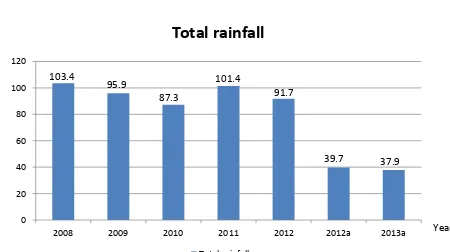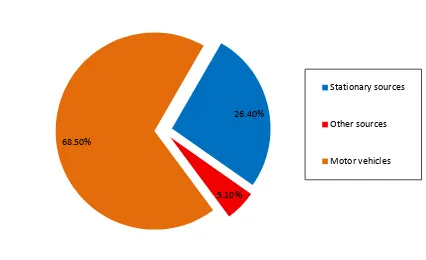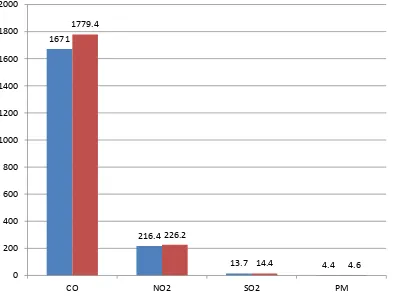SUPERVISOR DECLARATION
“I hereby declare that I have read this thesis and in my opinion, this thesis is sufficient in terms of scope and quality for the award of the degree of
Bachelor of Mechanical Engineering (Automotive)”
MOBILE SOURCE EMISSION INVENTORY IN MBMB AREA
MUHAMMAD SYAFIQ BIN SAFIZA
This report is submitted in partial fulfillment of requirements in order to be awarded with
Bachelor Degree of Mechanical Engineering (Automotive) with Honours
Faculty of Mechanical Engineering Universiti Teknikal Malaysia Melaka
DECLARATION
“I hereby declare that the work in this thesis is my own except for summaries and quotations which have been duly acknowledged.”
ACKNOWLEDGEMENT
Alhamdulillah, I am able to finish this thesis. I want to express my gratitude to my supervisor, PM. Dr. Noreffendy Tamaldin who supported me throughout the course of finishing this thesis. His guidance is very helpful and I could not have imagined having a
better supervisor for my Final Year Project other than him.
Besides my supervisor, I would like to thank to my co-supervisor, Dr. Nona Merry Merpati Mitan, for her guidance and insightful comments.
Last but not least, I would like to thank my family: my parents Safiza bin Mahmud and Sabariah binti Ibrahim, my family, my friends, my classmate and anyone that help and
ABSTRACT
ABSTRAK
TABLE OF CONTENT
LIST OF ABBREVIATIONS AND SYMBOLS ix
CHAPTER 1 INTRODUCTION 1
1.0 Introduction 1
1.1 Problem Statement 1
1.2 Objectives 3
1.3 Scope 3
CHAPTER 2 LITERATURE REVIEW 4
2.3.2 Human Activities 8 2.3.3 Mobile Source 9 2.3.4 The Effect Of Mobile Source Emission 10 Load
2.4 Past Research 11
CHAPTER 3 METHODOLOGY 14
3.0 Introduction 14
CHAPTER 4 RESULTS AND DISCUSSION 20
4.0 Intro 20
CHAPTER 5 DISCUSSION AND ANALYSIS 28
CHAPTER 6 CONCLUSION AND RECOMENDATION 31
6.0 Conclusion 31
6.1 Recommendations 31
REFERENCES 32
LIST OF TABLE
Table Page
2.1 API status used in Malaysia 8
LIST OF FIGURE
Figure Page
2.1 Total rainfall in Malaysia from 2008 to 2013 7 2.2 Emission discharge to the atmosphere by source in Malaysia for year
2012. 9
2.3 Total emission of CO, NO2, SO2, and PM to the atmosphere from motor
vehicles in year 2011 and 2012. 10
3.1 Project Flow Chart 15
3.2 MBMB Area 16
3.3 1st Quarter Of MBMB Area 16
4.2 Annual emission rate of carbon monoxide, CO by vehicle type in 1st
quarter of MBMB area in 2014 20
4.3 Annual emission rate of carbon dioxide, CO¬2 by vehicle type in 1st
quarter of MBMB area in 2014 21
4.4 Annual emission rate of nitrogen oxide, NO2 by vehicle type in 1st
quarter of MBMB area in 2014 22
4.5 Annual emission rate of particulate matter, PM by vehicle type in 1st
quarter of MBMB area in 2014 23
4.6 Annual emission rate of sulfur dioxide, SO2 by vehicle type in 1st quarter
of MBMB area in 2014 24
4.7 Annual emission rate of hydrocarbon, HC by vehicle type in 1st quarter
LIST OF ABBREVIATIONS AND SYMBOLS
API = Air Pollution Index CCTV = Closed Circuit Television CO = Carbon monoxides CO2 = Carbon dioxides
DOE = Department of Environment Malaysia EF = Emission Factors
GHG = Greenhouse Gases HC = Hydrocarbon
HDV = Heavy Duty Vehicles HOX = Hydrogen oxide radicals I/M = Inspection or Maintenance IVE = International Vehicle Emission LDV = Light Duty Vehicles
MBMB = Malacca Historical City Council NOX = Nitrogen oxides
NO2 = Nitrogen dioxides PM = Particulate Matter
CHAPTER 1
INTRODUCTION
1.0 INTRODUCTION
On the date of May 16, 2011, the YAB Datuk Seri Mohd Ali Rustam, Chief Minister of Malacca, had set a target to realize the vision “Melaka Maju Negeriku Sayang, Negeri Bandar Teknologi Hijau” by 2020. With this vision, Historical Malacca City Council support and give priority to sustainable development and green technology. This research is a collaboration between Universiti Teknikal Malaysia Melaka (UTeM) and Majlis Bandaraya Melaka Bersejarah (MBMB). This research is a way of obtaining the data of air pollutant which later can be used by the Government of Malacca to control the rate of air cleanliness by planning the emission inventory in the state of Malacca.
1.1 PROBLEM STATEMENT
episodes due to trans-boundary pollution. Emissions produced by it can affect air quality worse, leading to air pollution. The impact of air pollution to human health is bad that may lead to many diseases.
Carbon monoxide (CO) is one of common and widely distributed air pollutants. It is a colorless, odorless, and poisonous gas. Carbon monoxide has a slightly lower density than air. Carbon monoxide is poisonous because when it get into a human body, it will react easily with hemoglobin in our blood. The result of the reaction is carboxyhaemoglobin (COHb). When carbon monoxide binds to hemoglobin, it cannot be released as easily as oxygen. Thus, less oxygen will be transferred into the body. Children, pregnant woman and babies are easily affected by this poisonous gas, which will result to neurological damage.
Nitrogen Oxide (NOX) is a mixture of gases that composed of nitrogen and oxygen. Nitric oxide and nitrogen dioxide are two of most toxicological nitrogen oxides. Nitrogen oxide that is produced from the exhaust of motor vehicles are released to air will react to the air and produced nitric acid, which lead to the production of acid rains. Human exposure to high levels of nitrogen oxides can damage the respiratory airways. The skin or eyes can cause stinging if contacted with nitrogen oxide.
Hydrocarbon (HC), gases are a combination of hydrogen and carbon gas. The results from unburned or partially burned fuels that are diffused by the engine as exhaust and when fuel evaporate straightly into the atmosphere will produce HC pollution. There are many toxic compounds found in hydrocarbon gas, which may cause cancer.
Carbon dioxide (CO2) is the primary greenhouse gas emitted through human activities.The concentration of CO2 affects the temperature in the surrounding area.
1.2 OBJECTIVES
1. To explore emissions inventory produce for small cities in the state of Melaka.
2. To apply the emissions inventory procedure to the MBMB enforcement area.
3. Develop the emissions inventory for on-road mobile sources within the first quarter of MBMB area.
1.3 SCOPE
1. The emission inventory for this thesis covers the road that in the first quarter of MBMB area which include roads at Sungai Udang, Tangga Batu, Tanjong Keling, Bukit Rambai, Klebang Besar, Bertam, Balai Panjang, Cheng, Tanjong Minyak and Paya Rumput.
2. The type of road is divided into 4 categories, which are industrial road, residential road, city road and village road.
3. The source emissions inventory only takes into account of the resources for the on-road mobile.
4. Conduct on-road mobile count using video recording at the selected area. 5. There are six types of pollutions that are involved in the emissions
CHAPTER 2
LITERATURE REVIEW
2.0 INTRODUCTION
The emission inventory process is a work of collecting data of emission from the pollution sources at a certain area. It is also a process to determine the pollution gases such as CO, CO2, HC, NO2, PM and SO2 from on-road mobile source. Emissions inventory and air quality monitoring are valuable tools for identifying air quality which can help to reduce the global warming in the area.
2.1 POLLUTANT
2.1.1 PRIMARY POLLUTANT
The primary pollutant is substances that are emitted directly from the source into the atmosphere. Example of primary pollutant is smoke produce during open burning, exhaust gas from a car and gases released from a factory. The following pollutant is some primary pollutants that are harmful if the concentration of it are high enough:
1. Carbon compounds, such as CO, CO2, and CH4 2. Sulfur compounds, such as SO2 and H2S. 3. Nitrogen compounds, such as NO, and NH3. 4. Particulate Matter (PM), such as PM2.5 and PM10.
2.1.2 SECONDARY POLLUTANT
Secondary pollution is a pollution that produces directly from the source. It is a derivation from the primary pollutant. The following pollutant is the some of the main substance know that can cause harm if the concentration is high:
1. NO2 and HNO3 that produce from NO
2. Sulfates and nitrate aerosols formed from reactions of sulfuric acid and nitric acid in the air with NH3, respectively
3. Ozone (O3) produces from the photochemical reaction of nitrogen oxide and VOCS
2.2 AIR POLLUTANT SOURCE
Air is a composition of gases, including about 78 per cent of nitrogen, 21 per cent of oxygen and 1 per cent other gases. Air is polluted when the global concentration of greenhouse gases increased.
Pollutant source is divided into two categories which are anthropogenic source and natural source. Anthropogenic source is a source that is man-made. It started when a human began burning fuels. Anthropogenic sources can be divided into two main sources which are mobile source (on-road/non-road) and stationary source (point and non-point). Point stationary source is described as a source of air pollution that does not move from location to location. Examples of point stationary source are factory, fuel terminal and coal mines. As for non-point stationary source, it is a source that include several small stationary sources. Examples of it are parking area and gas station.
The mobile source is a source that originates from a vehicle or equipment that produce a pollutant when it moving. Mobile source also divided into two types of source which are on-road mobile source and non-road mobile source. Examples of on-road mobile source are car, motorcycle, van, and bus. Whereas non-road mobile source examples are locomotive, airplane and ship.
2.3 HUMAN IMPACT ON CLIMATE CHANGE
Total annual rainfall in 34 selected meteorological stations, has decreased from 101,400 mm in 2011 to 91,700 mm in 2012. So also, within the first six months in 2012 and 2013, the amount of rain also declined from 39 700 mm to 37,900 mm. 2012a and 2013a data was taken from January to June
2.3.1 AIR POLLUTANT INDEX
In the year 1993, the Department of Environment (DOE) of Malaysia has developed the first air quality index system, known as the Malaysian Air Quality Index (MAQI). The Air Pollutant Index (API) was introduced in 1996 which replaced MAQI system. An index system is an important tool to determine the air quality from good to hazardous (Department of Environment, 2013). Table 2.1 below show the API status used in Malaysia.
Table 2.1: API status used in Malaysia (Department of Environment, 2013)
API Status
0-50 Good
51-100 Moderate
101-200 Unhealthy
201-300 Very Unhealthy >300 Hazardous
2.3.2 HUMAN ACTIVITIES
Figure 2.2: Emission discharge to the atmosphere by source in Malaysia for year 2012. (Source: Compendium of Environment Statistics, 2013)
2.3.3 MOBILE SOURCE
Mobile sources account for more than half of all the air pollution in the United States and even more in Mecklenburg County. The emission from mobile source continues to increase at a faster pace than other sources. This is because the number of vehicle register in the country increases every year (Mecklenburg County, 2013).
Figure 2.3: Total emission of CO, NO2, SO2, and PM to the atmosphere from motor vehicles in year 2011 and 2012.
(Source: Compendium of Environment Statistics, 2013)
2.3.4 THE EFFECT OF MOBILE SOURCE EMISSION LOAD



